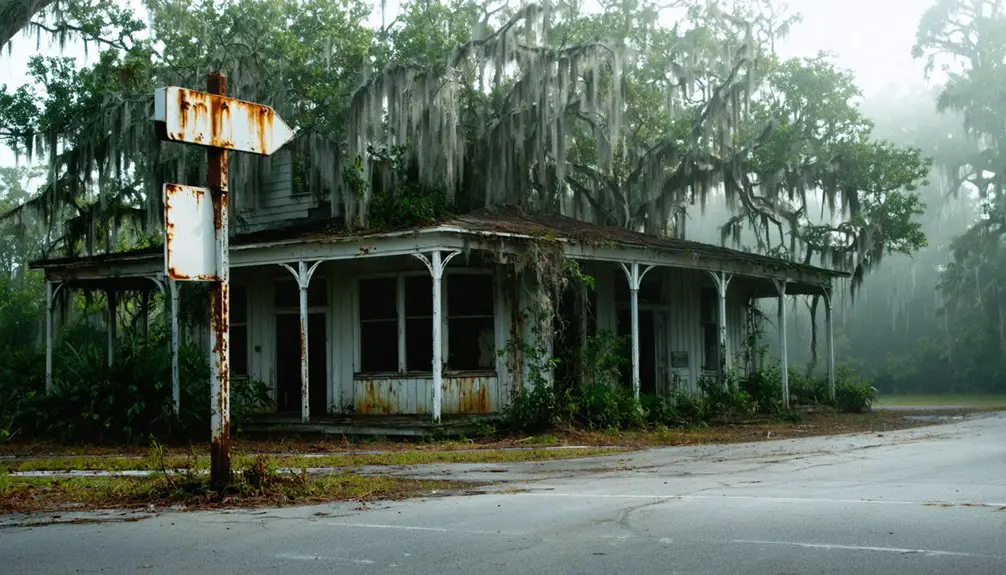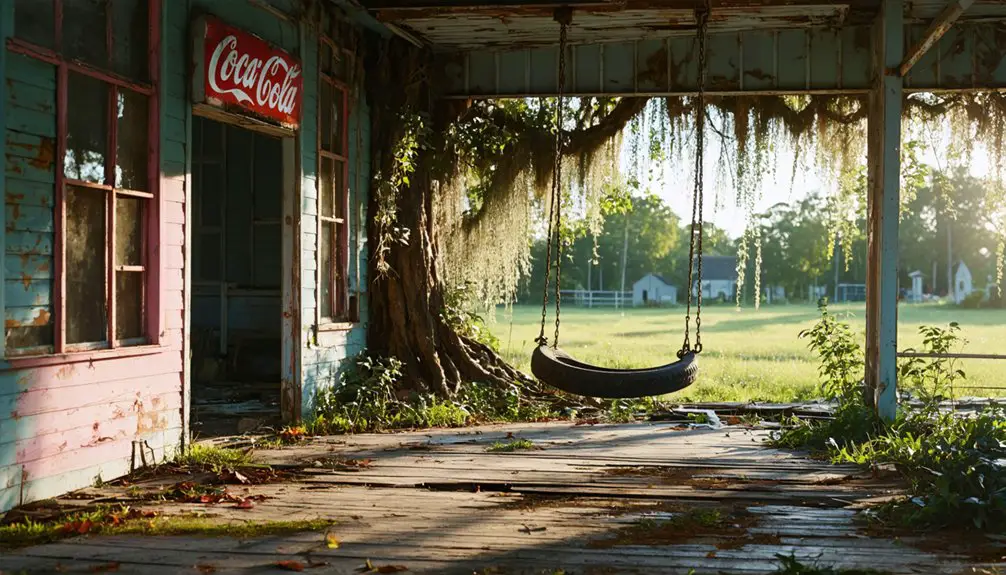You’ll find Vandolah, Florida about seven miles west of Wauchula, marked today by a lone railroad crossing. This ghost town flourished from 1886 to 1935 as a sawmill community established by M.H. Vandolah, featuring a general store, post office, and hotel that served as crucial gathering spots. Devastating fires, mosquito-borne illnesses, and the sawmill’s closure led to its abandonment, but the town’s story reveals fascinating insights into Florida’s railroad-dependent communities.
Key Takeaways
- Vandolah was a railroad-dependent settlement in Hardee County, Florida, established by M.H. Vandolah in the late 19th century.
- The town’s economy centered around logging operations from 1929-1935, with a sawmill serving as the primary employer.
- Major fires caused nearly $1 million in damages to the sawmill, contributing to the town’s eventual economic decline.
- The closure of the sawmill triggered a chain reaction of business failures, including the post office, school, and general store.
- Today, only a railroad crossing west of Wauchula remains to mark the location of this former bustling community.
Origins and Early Settlement
During the late 19th or early 20th century, M.H. Vandolah left Fort Wayne, Indiana, to establish a new settlement in Florida’s Hardee County. His settler motivations aligned with many northerners seeking opportunities in the region’s developing frontier.
Like many northerners drawn to Florida’s frontier possibilities, M.H. Vandolah ventured south from Indiana to forge a new community.
The town that bore his name quickly took shape as a self-sufficient community. Like the early settlers of Viking Town, the area’s pioneers established plantations that shaped the local economy. The arrival of the Florida Southern Railway in 1886 helped spur development in the region.
You’ll find that Vandolah’s early development reflected the cultural influences of its northern founders while adapting to Florida’s unique landscape. The settlement emerged during a period of regional transformation, following decades of pioneer challenges including Native American conflicts and Civil War disruptions.
The area’s opening for settlement in 1854 had already established a foundation for communities like Vandolah, with nearby Fort Green and Fort Hartsuff providing security since 1856. Early settlers focused on agriculture, timber harvesting, and trade.
The Rise of a Rural Community
You’ll find Vandolah’s early growth directly tied to the Wauchula Development Company‘s establishment of a new depot, which connected the rural settlement to neighboring communities.
The town’s strategic location, about seven miles west of Wauchula, made it an ideal hub for the region’s thriving citrus and vegetable farming operations. The area’s fertile lands were enriched by the nearby Peace River system.
The development of railroad infrastructure proved essential for local farmers and ranchers, who could now efficiently transport their agricultural products to broader markets.
Early Infrastructure Development
As pioneers ventured into the Florida frontier in 1849, the Kennedy-Darling Indian trading post near Paynes Creek marked the first significant infrastructure development in what would become Vandolah.
After its destruction that July, the military presence expanded with Fort Chokonikla’s establishment, though malaria forced its abandonment by 1850.
You’ll find that during the Third Seminole War, Fort Green and Fort Hartsuff emerged, with the latter eventually becoming Wauchula.
Transportation routes grew alongside these military installations, with Paynes Creek serving as an essential waterway for trade.
The region’s sawmills required extensive infrastructure, including docks, ramps, and storage facilities to support logging operations.
Worker housing, general stores, and boarding houses sprouted up around these industrial hubs, creating the foundation for a thriving community.
The town’s economy flourished as workers processed valuable old growth cypress harvested from nearby swamps.
Much like Jensen Beach’s current situation with abandoned buildings, the area experienced periods of structural deterioration that impacted local development patterns.
Agricultural Settlement Patterns
While the Seminole Wars reshaped Florida’s interior landscape, agricultural settlement in Vandolah emerged through a distinct pattern of family farms and diverse crop cultivation.
You’d find settlers adapting to the subtropical climate by practicing sustainable farming methods, rotating between vegetables like cucumbers, peppers, and squash while maintaining citrus groves.
The rich, arable soil supported this agricultural diversity, with farmers establishing roughly 1,560 acres of vegetable production by the early 2000s.
You’ll notice how these early settlers balanced cash crops with staple vegetables, creating a resilient farming community. Their crop rotation practices helped maintain soil health while managing economic risks.
Family-operated farms formed Vandolah’s backbone, with agricultural infrastructure centered around local needs rather than urban development. These farming practices and historical records are now preserved through digital collections access at the University of Florida.
Daily Life in Vandolah
You’d find the heart of Vandolah’s social life centered around the general store, where residents gathered to exchange news and purchase supplies while conducting their daily business.
The sawmill’s work whistle marked time for the town’s laborers, who spent their days processing local timber, while children attended the modest schoolhouse for their education. The nearby Consolidated Naval Stores operated a significant mill operation that employed many of the town’s residents. Like many Florida ghost towns such as Hampton Springs Hotel, the once-bustling community gradually faded into history.
The post office served as another community hub, where you could catch up with neighbors while collecting mail that connected Vandolah’s residents to the wider world.
Community Gathering Spots
Three primary gathering spots formed the social heart of Vandolah during its heyday: the general store, hotel, and post office. You’d find locals exchanging news and sharing stories at the general store, where social interactions naturally flourished amid daily shopping.
The hotel hosted occasional events and housed travelers, creating opportunities for communal activities and conversations between residents and visitors. Similar to how modern users explore trending creators today, residents would seek out social connections and entertainment at these venues. The town was established by M.H. Vandolah who relocated from Fort Wayne, Indiana to create this once-thriving community.
Beyond these main hubs, you’d discover informal meeting places throughout town. The railroad crossing drew folks who’d gather to watch passing trains, while the sawmill – before its devastating 1898 fire – served as both workplace and social center.
Seasonal markets and agricultural events brought the community together, with Cracker farmers and cattlemen maintaining tight-knit relationships typical of rural Florida life.
Work and School Routines
As sunlight crept over Vandolah’s horizon, the town’s daily rhythms sprang to life with sawmill whistles and the clatter of railroad activity. You’d find workers heading to the timber mills while farmers made their way to the vegetable fields, cultivating crops like cucumbers, peppers, and tomatoes.
Labor demands fluctuated with the seasons, shaping the town’s working patterns from dawn to dusk.
School attendance reflected this agricultural rhythm, with children’s schedules adapted to farming cycles. You’d see youngsters in their small, multi-age classroom learning basic literacy and practical skills, though they’d often help with planting and harvesting when needed.
The schoolhouse doubled as a community hub, where you’d find townspeople gathering for meetings even after classes ended, cementing Vandolah’s close-knit character.
Economic Activities and Infrastructure
While logging dominated Vandolah’s economy between 1929 and 1935, the town’s infrastructure centered around its mill operations and company-controlled commerce. The logging practices brought both prosperity and peril, with steam boilers causing devastating fires that resulted in nearly $1 million in damages in today’s money.
You’d find the company exercising economic control through their store system, where workers could only exchange company scrip for goods.
The town’s key economic elements included:
- The Florida Southern Railway, essential for transporting lumber and supplies
- A mix of permanent and temporary mill structures supporting daily operations
- Company stores that functioned as restricted economic hubs
After Vandolah’s decline, the surrounding Hardee County transformed into agricultural land, focusing on cattle, citrus, and diverse vegetable farming.
The Path to Abandonment

Despite its promising start as a lumber town, Vandolah’s path to abandonment began through a combination of geographic isolation and infrastructure limitations.
You’ll find that population dynamics shifted dramatically as the town’s economic foundations crumbled. The closure of the sawmill triggered a cascade of business failures, while the deterioration of rail services cut off crucial transportation links that had once sustained the community.
When the sawmill closed its doors, Vandolah’s economic heart stopped beating, leaving only empty streets and broken dreams behind.
You can trace the town’s decline through the gradual loss of essential services – the post office, school, and general store all shuttered as residents sought opportunities elsewhere.
The challenging environment, including mosquito-borne illnesses and dense wilderness, didn’t help matters. Vandolah’s isolation grew more pronounced as dirt roads remained inadequate for modern travel, and the abandoned railroad crossing served as a final reminder of the town’s fading relevance.
Historical Legacy and Present Day
Today, you’ll find little evidence of Vandolah’s once-bustling community beyond a solitary railroad crossing west of Wauchula. The ghost town’s legacy lives on primarily through historical records and cultural references, including an indie rock band that adopted its name.
While the physical structures have vanished, Vandolah’s story reflects broader patterns of Florida’s development:
- It demonstrates how railroad-dependent communities could flourish and fade.
- It exemplifies the migration of Northern settlers, like founder M.H. Vandolah from Indiana, to Florida.
- It showcases the rise and fall of small-town economies centered around sawmills and commerce.
Though the buildings are gone, Vandolah’s history continues to attract railroad enthusiasts and ghost town explorers who value the freedom to discover Florida’s forgotten places.
Frequently Asked Questions
Were There Any Notable Crimes or Unsolved Mysteries in Vandolah’s History?
Despite local whispers of ghost stories, you won’t find documented unsolved crimes in Vandolah’s history. The only real violence occurred miles away at Paynes Creek’s trading post in 1849.
What Was the Peak Population of Vandolah During Its Most Prosperous Years?
You won’t find exact Vandolah demographics, but historical evidence suggests the ghost town’s peak population likely reached between 100-300 residents during its most prosperous period in the early 1900s.
Did Any Famous Personalities or Historical Figures Ever Visit Vandolah?
You won’t find any documented celebrity sightings or historical visits to this location. Available records don’t show any famous personalities stopping by during the town’s brief existence from settlement to abandonment.
What Natural Disasters or Significant Weather Events Impacted the Town?
You won’t find documented records of specific hurricane impacts or flood damage in Vandolah, though the area faced typical Central Florida weather patterns including seasonal thunderstorms and potential tropical storm effects.
Are There Any Preserved Artifacts From Vandolah in Museums Today?
You won’t find preserved items from Vandolah in major Florida museums today, as there’s no documented collection focusing on this ghost town’s historical significance in any public institution’s archives.
References
- https://www.fortwaynereader.com/story.php?uid=2193
- https://freepages.rootsweb.com/~crackerbarrel/genealogy/Hardee21.html
- https://www.ghosttowns.com/states/fl/vandolah.html
- https://en.wikipedia.org/wiki/List_of_ghost_towns_in_Florida
- https://www.wikiwand.com/en/articles/List_of_ghost_towns_in_Florida
- https://www.youtube.com/watch?v=TxBONhwNi1k
- https://www.youtube.com/watch?v=ov9YSsKtbDs
- https://www.saw.usace.army.mil/Portals/59/docs/coastal_storm_damage_reduction/TBGRR/Appx_L_USFWSCAR.pdf
- https://storymaps.arcgis.com/stories/9679303bb8ce44128423a75dd7d50e66
- https://usgenwebsites.org/flgenweb/FLHardee/resources/newstidbitswauchula.html



